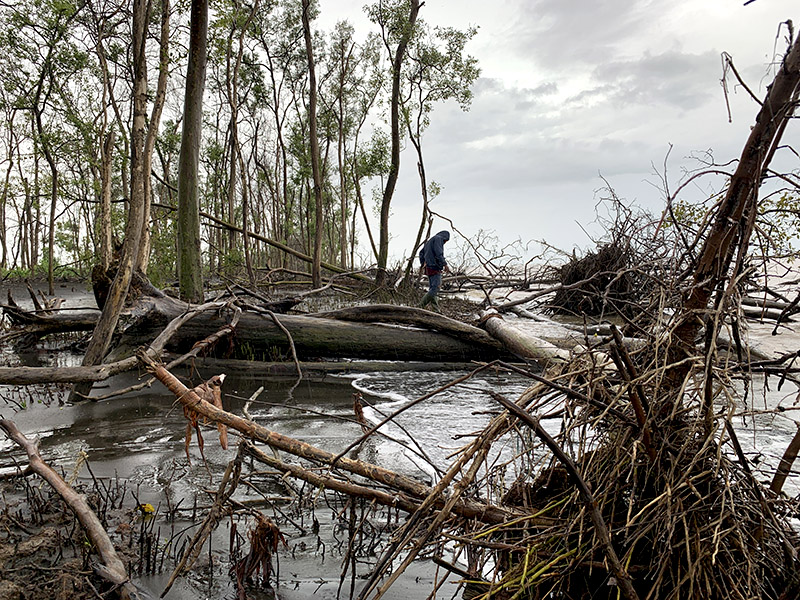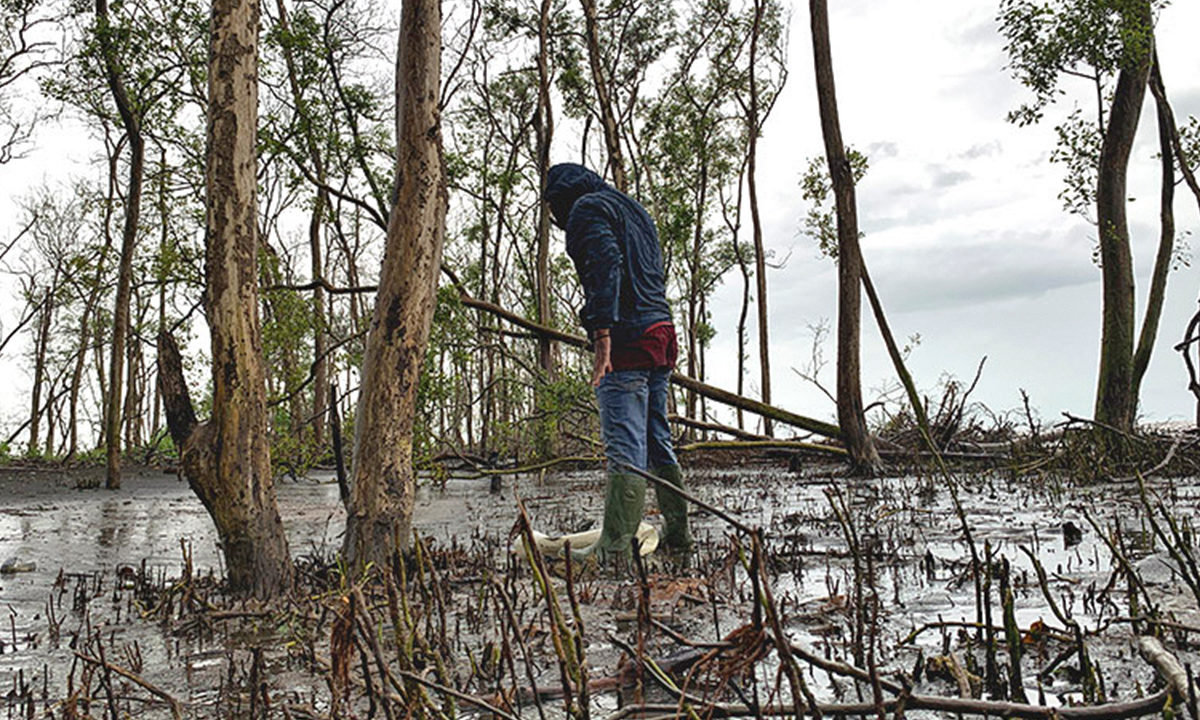- Last year, a 100-hectare patch of mangrove trees in eastern Sumatra was cleared to make way for an oil palm plantation.
- Residents say small landowners’ claims were packaged together to form a plantation, averting the need for environmental checks or permits required of a corporate concession.
- Mangrove restoration is a pillar of Indonesia’s climate change agenda, though the clearing of some intact forests has persisted.
EAST TANJUNG JABUNG, Indonesia — Ambo Angke trudged through the cemetery knowing he had been right to worry. A high tide surge had inundated the resting place here on the eastern coast of Sumatra after developers ripped out the trees protecting the shoreline.
“The mangroves were completely cleared,” Ambo, 48, told Mongabay Indonesia in November as we walked under light rain through the village of Sungai Sayang.
Excavators had noisily leveled 100 hectares (250 acres) of mangrove trees here in Sadu subdistrict, on the coast of Jambi province. The clearing prepared the ground for a new oil palm plantation. But in doing so, it removed the natural shield between village and sea, leaving behind a plain of mud and deadwood.
Indonesia is the world’s largest archipelagic country, and accounts for the world’s largest estate of mangrove forests. However, research shows almost half of Indonesia’s mangroves have been damaged or destroyed, often for charcoal production or to make way for aquaculture and oil palms, which provide livelihoods for millions but apply pressure on landscapes.
In recognition of these shifts, President Joko Widodo set ambitious targets to replenish Indonesia’s ailing mangroves. The government aims to plant 600,000 hectares (1.48 million acres) of mangrove seedlings by 2024, an unprecedented goal that few expect will be achieved by the time the president ends his final term that same year.
Despite ongoing efforts to rehabilitate ailing mangroves across the country, a national priority, the clearing of some intact mangrove forests persisted during the COVID-19 pandemic.
Jambi is one of eight mainland provinces on the island of Sumatra and is home to Berbak Sembilang National Park, Southeast Asia’s largest swampland, and Bukit Duabelas, home to the nomadic Orang Rimba people.
Much of Jambi’s forest was cleared over the past half century to make way for oil palm and pulpwood plantations. Meanwhile, less than half of Jambi’s 10,000-hectare (25,000-acre) mangrove estate is in satisfactory condition, according to the local maritime affairs department.
Sadu subdistrict in East Tanjung Jabung district, where Ambo’s village is located, accounts for some of the most extensive damage. The local government considers 627 hectares (1,549 acres) of mangrove forests to be damaged or destroyed, like the flooded cemetery in Sungai Sayang.

Law of the land
Around 2015, Ambo recalled, a number of residents of Sungai Sayang were asked to gather together and bring their identity cards.
Residents said the land-use change began with a meeting between Hariyanto, the owner of PT Erasakti Wira Forestama (EWF), and Rusdianto, a member of the East Tanjung Jabung district council.
“There are those who wanted to invest, so we facilitated it,” Rusdianto told Mongabay in the Hok, a neighborhood of Jambi city named after a prominent Chinese rubber trader.
Rusdianto and Hariyanto had known each other for years. The future councilman had once sold the businessman 20 hectares (49 acres) of land in the village next to Sungai Sayang. EWF also has a 6,314-hectare (15,602-acre) oil palm concession in another district in Jambi.
Rusdianto said Sungai Sayang was a deprived area that had yet to receive meaningful investment. Plans to construct a port nearby in Ujung Jabung had stalled, and three successive district heads of East Tanjung Jabung had failed to achieve breakthroughs, he said.
“Just look at the roads over there — they’re destroyed,” Rusdianto told Mongabay.
Rusdianto asked the Sungai Sayang village chief at the time, Noferiadin, to assemble residents from two hamlets in the village and collect all the documents to their land. That was when Ambo was asked to submit his national ID card.
Noferiadin corralled 30 landowners and packaged their land deeds, which covered a combined 130 hectares (321 acres). He used his authority as village chief to issue the authorization needed to legalize the status of the land for sale to Hariyanto, with Rusdianto acting as a middleman. (Hariyanto and his associates did not respond to multiple requests for comment.)
Noferiadin said the area was originally rice fields and coconut farms, but that the landowners had abandoned the area in the 1980s after brackish water overwhelmed the rice fields. Some landowners moved to higher ground or returned to their home regions. The mangrove trees eventually took over the land, he said.
“I offered to sell [the land] when no one wanted to buy it,” Noferiadin said during a phone call. “Rather than have land that they can’t farm, it’s better to sell it for money.”

Information obtained by Mongabay showed that the sale was valued at 5.28 billion rupiah ($353,000), but that the landowners had received only 551 million rupiah ($37,000) at the time of writing. Rusdianto declined to comment on the amount he received from the deal.
“I can’t say, because it’s not in writing,” he said.
Dadan Mulyana, a senior researcher on mangroves at the Bogor Institute of Agriculture, said mangroves should be seen as “a green bulwark that will protect coastal areas from the brunt of sea waves.”
In Sungai Sayang, that protection is now gone, and Dadan views mangrove rehabilitation as vital to averting further disaster.
“If it is left [to recover] naturally without planting, it will take 150 years,” he said.
In 2020, 10 homes in Air Hitam Laut village were destroyed by a tidal surge, while abrasion occurred in several villages along Jambi’s 230-kilometer (143-mile) coastline, all attributed to the clearing of the coastal vegetation.
Around the time that the tidal surge flooded Sungai Sayang’s cemetery, Romi Hariyanto, the elected head of East Tanjung Jabung (no relation to Hariyanto, the EWF business owner), received the Wetland City Accreditation award at an assembly in Switzerland, the first local leader from Indonesia to receive the accolade.
Suhaili, a spokesperson for the district, told Mongabay Indonesia that East Tanjung Jabung was committed to wetland protection, and that the latest zoning plans contained protection guarantees for Cemara Beach, a rest stop for migratory birds.
“It is not only the mangroves that we pay attention to, but also the protected peat forest and TNBS,” Suhaili said, referring to Berbak Sembilang National Park.
However, he acknowledged that businesses buying up large swaths of coastal land directly from groups of smallholders is a challenge the government is poorly equipped to confront.
“We cannot stop residents from selling their land,” Suhaili said, adding that “the government does not have a solution for that yet.”
However, the district government acknowledged that the government opposed the end result — the removal of coastal mangroves.
“They should not have been cleared away,” Suhaili said. “This is for our future generations.”

Legal gray area
In September 2020, veteran environmental activist Arie Suryanto reported the clearing to the local police.
The lead detective with the East Tanjung Jabung Police said the force had yet to decide on how to pursue an inquiry because investigators had yet to receive a decision from the district government.
“If the regional government has issued administrative sanctions, it means we set aside the criminal penalties,” Ridho Prasetnya said. “We don’t know yet.”
However, Pramudia, the zoning chief for the district environmental agency, said he was at a loss for what mechanism to use, owing to the fact that the land was still technically owned by a collective of smallholders, averting the legal requirement for any permit to develop.
“There is no EIA [environmental impact assessment], no permit, so I’m confused about what kind of sanction to levy,” Pramudia said.
Asked whether an administrative sanction, such as a fine, could be averted if the mangroves were replanted. Pramudia replied, “We can think of it that way.”
Abdullah, director of the Jambi office of the Indonesian Forum for the Environment (Walhi), a national environmental advocacy group, said leaving the land in the name of the smallholders meant the real owner could develop without any bureaucratic checks.
“If they applied for permits for plantations, then the government would actually refuse them,” Abdullah said.
Ramos Hutabarat, head of a local legal aid institution, said the authorities needed to cut through the intransigence holding up progress.
“Land clearing carried out without a permit is clearly a criminal act,” Ramos said. “The police should continue without having to wait for the regional government’s decision.”

Food security
The light drizzle continued as Ambo reached the shore of Sungai Sayang, where thousands of mangrove stems lay strewn across the muddy peatland. The oil palm seedlings, planted in irregular intervals, lay just 20 meters (66 feet) from the shoreline in places.
Ambo said he doesn’t really understand the cause and effect of climate change. But he knows from lived experience, all too well, that something is changing in his community, and that the shifts appear out of control.
“There used to be crabs here, and in October we would begin to harvest them,” Ambo said.
When the seas turned rough, local fishers here would seek out the mud crabs that lived among the mangrove trees. A large mud crab might have fetched 120,000 rupiah per kilogram ($8 per kilo, or $3.60 per pound) on a good day.
“There are no more now,” Ambo said. “It’s finished.”
Banner image: A fisherman looks for crabs around the remaining mangrove trees on the beach in Sayang village. Photo by Teguh Suprayitno/ Mongabay Indonesia.
This story was reported by Mongabay’s Indonesia team and first published here on our Indonesian site on Jan. 15, 2023.
Indonesia’s mangrove restoration bid holds huge promise, but obstacles abound
